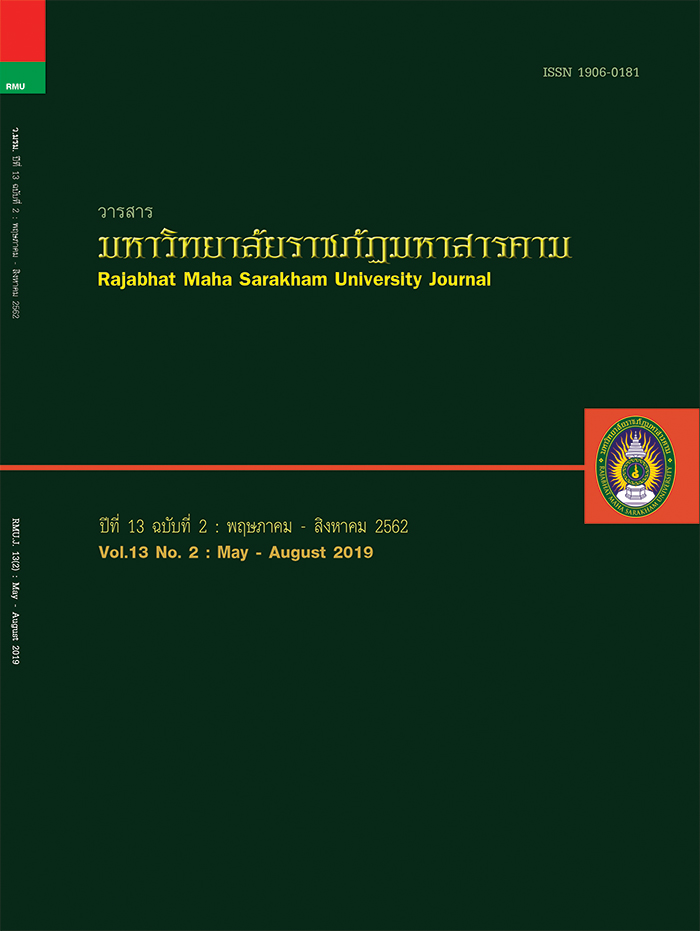The Development of Write Geometric Proofs Abilities on Congruence for Mathayomsuksa 2 Students Using Proof Mapping Instructional Technique
Main Article Content
Abstract
The purposes of this research were 1) Compare the ability to write geometric proofs in Congruence for Grade 8th students using proof mapping instructional technique between before learning and after learning.
2) Compare the ability to write geometric proofs in Congruence for Grade 8th students using proof mapping instructional technique between after learning and 60 % criteria. A samples were 37 Grade 8th students in the 1st semester of 2019at Chokchaisamakkee school. The research tools included 10instructional plans using proof mapping instructional and ability to write geometric proofs test. The collected data were analyzed using the percentage, means, the standard deviation, and the t-test statistics. The study result showed that: 1) The ability to write geometric proofs in Congruence for Grade 8th students using proof mapping instructional technique after learning was statistically higher than before learning at the .05level. 2) The ability to write geometric proofs in Congruence for Grade 8th students using proof mapping instructional technique after learning was statistically higher than the 60 percent criteria at the .05 level
Article Details
1. All articles undergo a thorough with at least three reviewers evaluating their suitability within the respective field of study, during the double-blind review.
2. The views expressed by individual authors do not represent the official views of the Editorial Boards of RMUJ: The author of each articie is responsible for all its contents.
3. The Editorial Boards do not reserve the copyrights. but proper citations need to be made.
References
Ministry of Education. (2017). Core Curiculum Studies Basic Curriculum 2551 (revised edition 2560). Bangkok : Agricultural Cooperatives of Thailand.
The institute for the Promotion of Teaching Science and Technology. (2002). Geometry. Bangkok : Agricultural Cooperatives of Thailand.
Herbst, P. G. (2002). Establishing a custom of proving in American school geometry : evolu-tion of the two-column proof in the early twentieth century. Educational Studies in Mathematics. 49(3), 283-312.
Hanna, G., de Villiers, M., & Internatioal Program Committee. (2008). ICMI Study 19 : Proof and proving in mathematics education. ZDM. 40(2),329-336.
KhawnPiasai (2004). A Study on the Ability of Undergraduate Mathematics Majors in Learning Mathematical Proofs Via Student - Centered Instructional Package. Master of Education Thesis.Bangkok : Srinakharinwirot University.
Cirillo, M., and Herbst, P. G. (2012). Moving toward more authentic proof practices in geometry. The Mathematics Educator, 21(2),11-33.
Linares, L. A. (2008). The Effects of a Proof Mapping instructional technique on high school geometry students and their ability to write geometric proofs. Masterof art thesis. Davis, CA: University of California, Davis.
Academic department. (2018,May). Ordinary National Educational Test. InKomet Hoaymuk (Chair), Monthly meeting.Organized by Chokchaisamakee School, Nakhonratchasima.
Solow, D. (2014). How to Read and Do Proofs: An Introduction to Mathematical Though Process.7 th ed. New York : John Wiley and Sons.
Linares, L. A. and P. R. Smith. (2009). Proof mapping. Mathematics Teacher. 103(4), 258-265.
Kamon Naksutthi. (2016). Effect of Organizing Mathematics Learning Activities Using Proof Mapping Technique to Write Geometric Proofs on Geometric Reasoning Ability of Eighth Grade Students. Master of Education Thesis.Bangkok : Chulalongkorn University.


